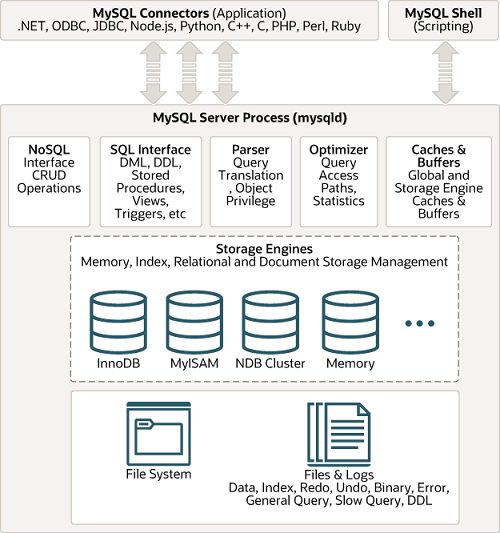Summary: in this tutorial, you will learn about MySQL architecture and understand its key components.
Introduction to MySQL Architecture
The following picture illustrates the client-server architecture:

MySQL follows the client-server architecture, which divides the system into two main components: Client and Server.
Client
- The client is the application that interacts with the MySQL database server.
- The client can be a standalone application, a web application, or any program that needs a database.
- The client sends SQL queries to the MySQL server for processing.
Server
- The server is the MySQL database management system responsible for storing, managing, and processing data.
- The server receives SQL queries, processes them, and returns the result sets.
- The server manages multiple clients’ data storage, security, and concurrent access.
The client communicates with the server over the network using MySQL protocol. The client-server architecture allows for the separation of concerns and enables multiple clients to interact with MySQL concurrently.
In the client-server architecture, the applications use MySQL connectors to connect to the MySQL database server. The applications can be developed using various programming languages such as Java, PHP, Python, Perl, and JavaScript (Node.js)
MySQL also comes with some of the MySQL client tool that allows you to interact with the MySQL database server:
- MySQL Workbench (GUI-based).
- MySQL client (terminal-based).
- MySQL shell.
MySQL database server includes several daemon processes:
- NoSQL manages schema-less data storage, often used for unstructured or semi-structured data.
- SQL Interface defines a standardized interface enabling applications to interact with relational databases using SQL queries.
- Query Parser is responsible for analyzing SQL queries to understand their structure and syntax, breaking them down into components for further processing.
- Query Optimizer evaluates various execution plans for a given query and selects the most efficient one to enhance the performance of database operations.
- Caches & Buffers store frequently accessed data or query results in memory, reducing the need to repeatedly access the underlying storage and improving overall system performance.
Storage engines
In MySQL, a storage engine is a component that is in charge of storage, retrieval, and management of data in the database.
MySQL uses a pluggable storage engine architecture that allows you to select different storage engines such as InnoDB, MyISAM, and others.
The pluggable storage engine architecture provides flexibility to meet specific performance and scalability requirements while maintaining a consistent SQL interface and overall database functionality.
File systems
The file system organizes and stores various file types, including data and index files. MySQL uses log files to maintain transactional consistency and support recovery mechanisms. Typically log files are binary and redo logs.
Summary
- MySQL follows a client-server architecture where clients send SQL queries to the server for processing.
- MySQL supports a pluggable storage engine that manages the storage and retrieval of data with different features and performance characteristics.